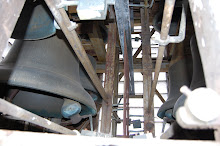By Alexandra Sanders
The Austin Cornelius Dunham Carillon in the Storrs Congregational Church was once used as a passing bell for students at the University of Connecticut. Today the tall steeple that remains the home to the carillon is used as a cell phone tower to broadcast signals from a telephone company.
Downstairs, the church is white and pristine with an immaculate set of stairs leading to the carillon. But with each ladder rung after the staircase, the thinner the air gets and the thicker the layers of dust and cobwebs become. The walls are partially brick and wood and they smell distinctly of a grandparent’s closet.
The room that is home to the carillon is about half the size of a dorm room and is a collision of past and present. There are rough-hewn, dusty wooden beams that support the telephone company cables and metal planks that are plastered with comics and pictures of the church. In the center of the room, sits the carillon – old and rustic, yet bright thanks to two vases of fake daffodils that adorn it.
The carillon is stuck in its own time. It looks out of place and forgotten in this era. Others may overlook it, but it is a coveted instrument to the player – or carillonneur.
The carillonneur for the demonstration was David Maker, a music professor at the university. He learned to play the instrument at Trinity College and now teaches others how to play it.
Maker’s cheerful expression and white hair didn’t fit the description of Quasimodo, but as he sat down and passionately banged his hands on the large wooden keys, the lights flickered, and at that moment – it was clear that he was meant to play the carillon.
He explained that the church is home to 31 bells, all owned by the University of Connecticut, although the church itself is privately owned. UConn students and Mansfield residents have mixed feelings about the noise that the old instrument causes.
“There are certain hours that you can play them,” said Maker. “They could be a nuisance. Some people think they are the most wonderful thing this side of heaven but others disagree.” As Maker pounds on the large keys, the room fills with banging and clinking blanketed by the sound of ringing bells. The noise seems to replace the musty air in the room and envelope the instrument that produces it.
“The instrument has only recently been thought of as a concert instrument,” Maker said with a pleased look on his face. The bells were previously only used for signals and occasions like weddings and funerals. The carillons were eventually used for musical purposes but then people lost interest and they didn’t gain popularity again until ten years ago.
“Tastes change,” said Maker. “People used to want to listen to the bells and then radio came out and they wanted that.” Listeners may alter with the times but the carillons remain the same.
The carillon has never been refurbished but Maker hopes that will change. Some of the batons clink when they are pounded on and Maker slides them to adjust the tuning. The carillonneur can’t control the length of the notes so the bells overlap, causing a sound that one would expect to be jumbled, but simply blends into itself. The sound is called a minor third and it creates stream of legato notes that carry out of the vent-like openings at the top of the church.
Because of noise pollution, and construction on campus, it is difficult to hear the bells. But years ago, they were used to define town boundaries and could be heard for miles. If someone could hear the carillon, he could be sure that he was still in Storrs, Conn.
“I’m told that on a good day, some people in Mansfield Center can still hear the bells,” said Maker.
Tuesday, May 12, 2009
Subscribe to:
Post Comments (Atom)

No comments:
Post a Comment